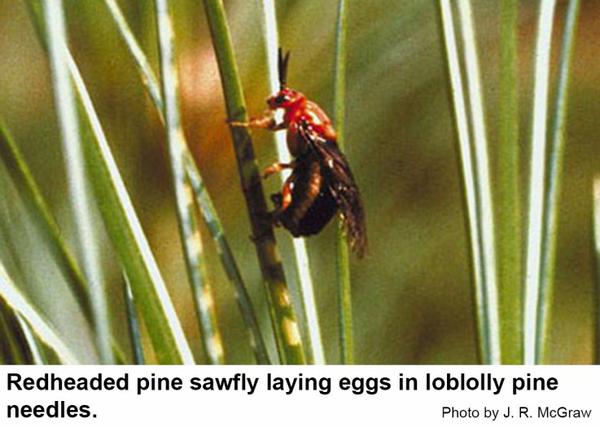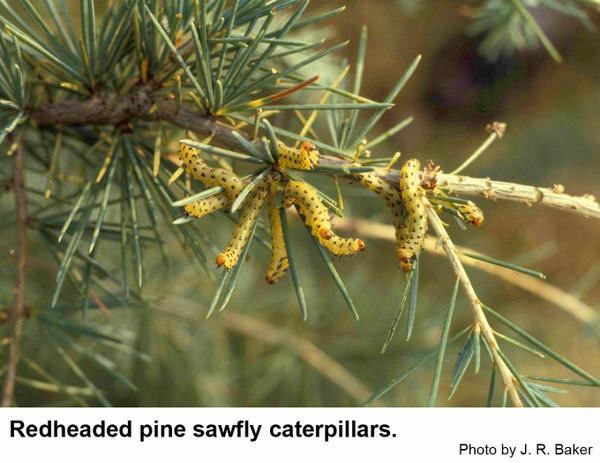Description and Biology
Sawflies are so-called because the adults resemble flies and the females have a sawlike ovipositor that they use to saw open leaves or needles to lay their eggs inside. Redheaded pine sawflies, Neodiprion lecontei, usually lay their 120 or so eggs in the needles of one twig of southern yellow pines and other hard pines. The needles are slightly swollen and discolored at each egg, and the egg is visible inside the slit. The females insert the eggs in a row. From the eggs hatch tiny caterpillars that resemble moth and butterfly caterpillars (but sawfly caterpillars have more legs). Redheaded pine sawfly caterpillars are often abundant locally and almost always feed gregariously. When mature, the worms usually crawl to the soil where they pupate in small (½ inch), brown cocoons. Within a few weeks small, fly-like adults emerge and mate. There are four or five generations each year. Pine sawflies overwinter as prepupae in cocoons. Some prepupae develop the following year whereas others may wait two or more years before developing.
Host Plants
Shortleaf, loblolly, and slash pines are some of the many species of pines infested by redheaded pine sawflies. They sometimes are found on a wide variety of conifers including spruces, cedars, and even larches (further north). Large pines may be noticeably defoliated and small trees may be outright killed.
Residential Recommendation
When only a few colonies of larvae are present on small ornamental pines, they can be picked or shaken from the trees and trampled underfoot. Redheaded pine sawflies are not particularly resistant to insecticides although mature caterpillars in cold autumn weather may seem to be tolerant. All insecticides labeled for caterpillar control in the landscape available in garden centers and plant shops should give more than adequate control.
References
- Caterpillars that Feed on Trees and Shrubs. Frank, S. D. and S. B. Bambara. 2009 (revised). Entomology Insect Notes, NC State Extension Publications
- Common name: redheaded pine sawfly, scientific name: Neodiprion lecontei (Fitch) (Insecta: Hymenoptera: Diprionidae). DeBerry, S. 2011 (reviewed 2021). Featured Creatures. Entomology & Nematology, FDACS/DPI, EDIS. Pub. No.: EENY-488.
- Insect and Related Pests of Shrubs. Baker, J. R. ed. 1980. NC Agricultural Extension Service publication AG-189. 199 pp.
- Extension Plant Pathology Publications and Factsheets
- Horticultural Science Publications
- North Carolina Agricultural Chemicals Manual
For assistance with a specific problem, contact your local N.C. Cooperative Extension Center.
This Factsheet has not been peer reviewed.
Publication date: Nov. 8, 2013
Revised: Oct. 11, 2019
Recommendations for the use of agricultural chemicals are included in this publication as a convenience to the reader. The use of brand names and any mention or listing of commercial products or services in this publication does not imply endorsement by NC State University or N.C. A&T State University nor discrimination against similar products or services not mentioned. Individuals who use agricultural chemicals are responsible for ensuring that the intended use complies with current regulations and conforms to the product label. Be sure to obtain current information about usage regulations and examine a current product label before applying any chemical. For assistance, contact your local N.C. Cooperative Extension county center.
N.C. Cooperative Extension prohibits discrimination and harassment regardless of age, color, disability, family and marital status, gender identity, national origin, political beliefs, race, religion, sex (including pregnancy), sexual orientation and veteran status.


